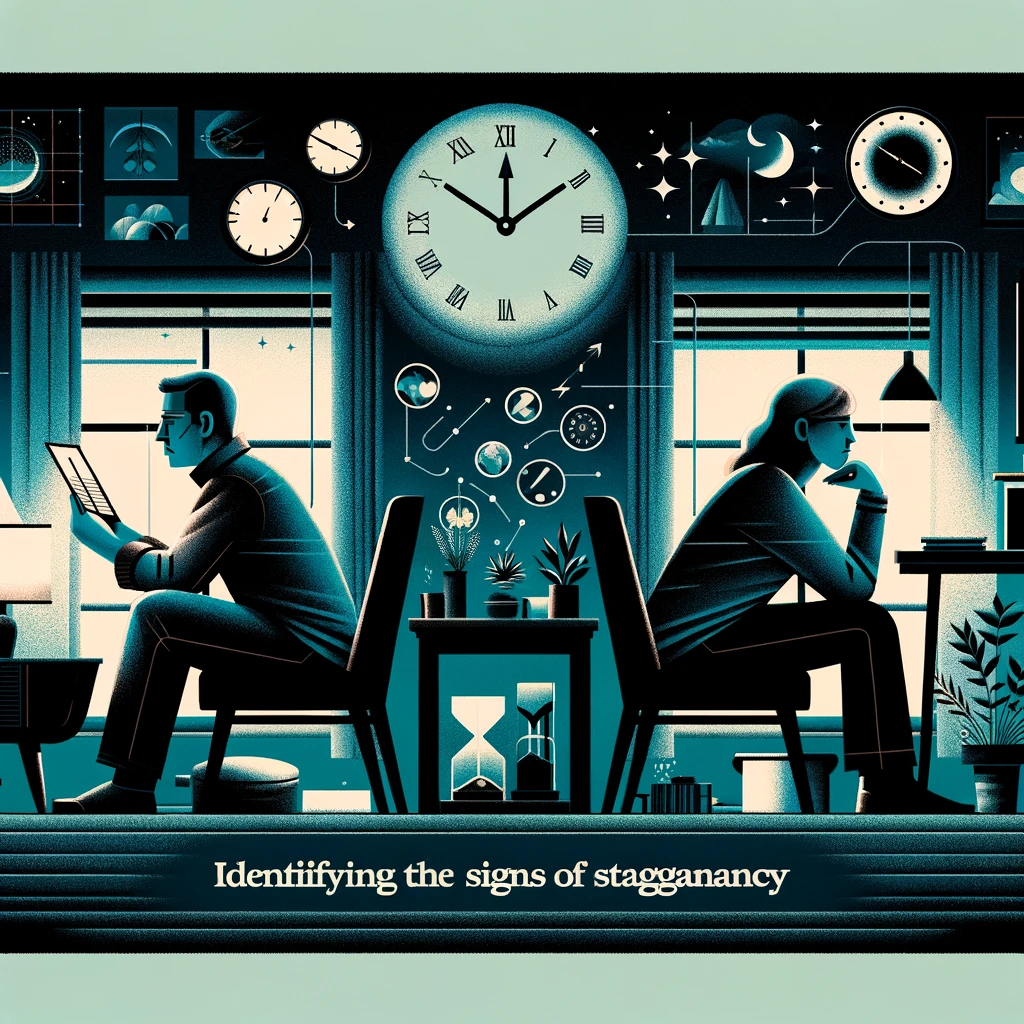Breathing New Life into a Stagnant Relationship

Have you ever found yourself questioning the vitality of your relationship, wondering where the vibrant energy that once electrified your connection has gone? You’re not alone. Many couples face periods where their relationship feels more like a calm lake than a flowing river—serene yet stagnant.
In a stagnant relationship, emotional intimacy wanes, routines become repetitive, and unresolved issues linger, leading to a state of complacency or disconnection. But there’s hope. Whether you’re dealing with emotional disconnect, the monotony of married life, or the aftermath of unresolved issues, remember that it’s possible to breathe new life into your partnership.
This article aims to guide you through the process of rejuvenating your relationship, offering practical advice, insights, and strategies to rediscover the growth, connection, and fulfilment you once shared. We’ll explore how you and your partner can move away from stagnancy towards a more vibrant life experience.
Identifying the Signs of Stagnancy

The journey to rejuvenating a stagnant relationship begins with recognizing its signs. These can range from feeling disconnected despite spending time together, to a pattern of negative feelings and constant arguments over the same issues.
Other indicators include a lack of physical affection and deep conversations. As a result, you and your partner may find yourselves feeling disconnected from each other’s lives and personal growth.
Addressing these signs involves setting realistic expectations and prioritizing emotional well-being. For those facing challenges like emotional or physical abuse, it’s crucial to seek professional help.
Enhancing your relationship’s health isn’t just about overcoming negativity; it’s about fostering a positive, supportive environment where both of you can thrive.
For couples looking to deepen their understanding of each other and improve their communication skills, our workbook “How to Communicate Better with Your Partner” offers valuable tools and exercises.
Additionally, exploring articles on intimacy issues and effective communication can provide further insights and strategies.
Laying the Foundation for a Healthy Relationship

Moving away from a stagnant relationship requires understanding and action towards building a healthier and more loving way to interact with your partner. Here are the essential components to lay a strong foundation:
- Set Realistic Expectations: Understand that both you and your partner have strengths and weaknesses. Accepting these can help manage expectations and foster a more supportive environment.
- Focus on Emotional Well-being: Addressing emotional and physical abuse is paramount. Creating a safe space for vulnerability allows for healing and growth.
- Develop Emotional Intimacy: Create space for quality time, active listening, and sharing future plans and feelings. This strengthens your bond and ensures you’re both aligned with each other’s needs and aspirations.
To navigate this transformative journey, consider leveraging the insights from the “7 Steps to a Healthy Relationship – A Complete Guide” workbook. This resource is designed to guide you through the nuanced aspects of fostering a healthy, loving relationship.
Further, for couples looking to deepen their connection, our articles on Trust in a Relationship and How to Improve Intimacy in Your Relationship can offer valuable advice and practical tips.
Strategies to Rekindle the Spark

With the foundation set, let’s explore actionable strategies to rekindle the spark in your relationship:
- Clarify Boundaries: Communication is key. Discuss and understand each other’s needs to ensure you’re both on the same page.
- Seek Professional Help: If emotional disconnect or past traumas are deeply rooted, professional guidance can offer new perspectives and coping strategies.
- Embrace New Experiences: Step out of your comfort zone together. Trying new activities can stimulate personal and mutual growth, bringing excitement back into your relationship.
Our workbook “How to Spice up Your Relationship” is a fantastic resource for couples looking to inject new life into their partnership. It offers creative ideas and exercises tailored to reignite passion and intimacy.
Navigating Challenges and Moving Forward

In the journey to rejuvenate a stagnant relationship, rebuilding trust and enhancing communication stand out as fundamental steps.
Trust, the bedrock upon which partnerships thrive, when shaken, can lead to a chasm of disconnect. Similarly, effective communication serves as the lifeline that keeps the relationship’s heart beating, ensuring both you and your partner feel heard, understood, and valued.
Restoring Trust
The erosion of trust can stem from a myriad of sources – misunderstandings, unmet expectations, or breaches of faith. To mend this, transparency is key.
Begin with open, honest dialogues about your feelings and fears. This vulnerability acts as a healing balm, slowly but surely restoring faith in each other. Consistency in words and actions builds this trust over time, demonstrating reliability and commitment to mutual well-being.
Equally, acknowledging past hurts without dwelling on them paves the way for forgiveness and growth. It’s about crafting a new chapter together, where trust is not just rebuilt but strengthened, capable of withstanding future challenges.
Enhancing Communication
Communication is the vessel through which emotions, needs, and dreams are conveyed. In stagnant relationships, this flow is often obstructed, leading to a build-up of frustration and misunderstanding. To clear these blockages, active listening is paramount.
It’s about genuinely hearing your partner, not just waiting for your turn to speak. This fosters empathy, allowing you to see the world through their eyes.
Incorporating “I” statements helps express your feelings without placing blame, reducing defensiveness, and opening the door to constructive dialogues. Setting aside dedicated time for these conversations ensures they are given the attention and respect they deserve.
This practice turns simple talks into profound exchanges, deepening the connection and understanding between partners.
Supporting Personal Growth
An often overlooked aspect of revitalizing a relationship is the role of personal growth and self-reflection. By investing in your personal development, you bring a richer, more fulfilled self to the partnership.
Encourage each other in pursuits outside the relationship, whether they be hobbies, educational goals, or personal wellness. This independence enriches the collective experience, ensuring the relationship remains vibrant and dynamic.
In essence, trust and communication are not just pillars but also the architects of a revitalized relationship. They design a foundation strong enough to support growth, change, and the deepening of love over time.
By committing to these principles, you and your partner can navigate the waters of stagnancy, steering towards a future filled with connection, understanding, and renewed affection.
Even with a strong foundation and renewed efforts, relationships will encounter challenges. It’s how you navigate these hurdles that can either strengthen your bond or contribute to stagnancy. Here are strategies to help you move forward:
- Accept Imperfection: Recognize that both you and your partner are human, with flaws and all. Embracing imperfection can lead to a more forgiving and understanding relationship.
- Keep the Lines of Communication Open: Share your feelings, fears, and desires openly without fear of judgment. This fosters trust and deepens the emotional bond.
- Rebuild Trust: Engage in activities that rebuild trust, such as spending quality time together, showing appreciation, and being supportive of each other’s goals.
For couples facing challenges in maintaining trust, the “How to Build Trust in Your Relationship” workbook offers practical exercises and insights to help rebuild and strengthen trust.
Additionally, considering professional support through therapy or coaching can be invaluable in overcoming challenges.
Relationship coaching can provide personalized advice and strategies tailored to your unique situation, offering new perspectives on stagnant relationship dynamics and strategies for enhancing emotional intimacy and personal well-being.
Discover more about how our relationship coaching can support your journey towards a rejuvenated relationship.
The Role of Professional Support

In some cases, navigating the path from a stagnant to a vibrant relationship requires more than just effort from both partners—it requires professional insight. Relationship coaching or therapy can provide:
- New Perspectives: A fresh look at your relationship dynamics and challenges.
- Strategic Advice: Practical steps and strategies for enhancing communication, resolving conflicts, and deepening intimacy.
- Support for Individual Growth: Encouraging personal development that, in turn, benefits the relationship.
If you’re considering professional help, check out our relationship coaching options to see if you and your partner still want the same things.
Our coaches specialize in various aspects of relationship dynamics and offer the support and guidance you need to navigate your way out of a stagnant relationship.
Conclusion
When a relationship feels stagnant, it can cast a shadow over every interaction, making partners question if they belong in the relationship anymore.
The feeling of being stuck in a lifeless relationship, where the physical connection has waned and strong feelings seem a relic of the past, is a clear sign that something must change.
This stagnancy often stems from underlying issues, perhaps unresolved conflicts from past relationships or patterns that hinder growth, leaving individuals feeling disconnected and lost.
Yet, recognizing these signs is the first step towards transformation. Signs of a stagnant relationship include:
- Constantly arguing over the same things
- Never finding a common ground
- Negative feelings have become part and parcel of your everyday life
- Lack of physical affection and deep conversations
- You and your partner feel disconnected from each other’s lives
By addressing these signs, you and your partner can navigate the complexities of a stagnant relationship, working towards a more fulfilling and dynamic partnership.
It’s essential to understand that moving away from a stagnant relationship doesn’t always mean walking away. Instead, it can involve walking towards a new relationship dynamic with the same partner, finding common ground, and reigniting the spark that once brought you together.
This journey may involve confronting broken aspects of the relationship, re-evaluating low expectations, and addressing any negative view that has taken root over time.
A stagnant relationship can serve as a wake-up call, urging both partners to engage in self-care, boost their self-esteem, and work collectively towards a healthy relationship.
The process is akin to obtaining a master’s degree in understanding each other—requiring study, effort, and the willingness to see things from your partner’s perspective. Along the way, you might realize that while no relationship is perfect, every relationship has the potential to grow, evolve, and allow you and your partner to feel fulfilled.
Feel free to explore our articles and open yourselves up to the possibility of getting help and guidance from experienced professionals in the field of relationship coaching who can offer you insights and strategies for addressing feeling stagnant.
Recognize that a stagnant relationship is a bad sign, but it’s also an opportunity for personal and mutual growth, a chance to redefine what your long-term relationship looks like.
As time passes, it’s normal for relationships to go through several stages, from the honeymoon phase to deeper, more complex levels of intimacy and connection.
Embracing these changes, finding new ways to connect, and ensuring that both partners feel understood and valued can transform a stagnant or broken relationship into a source of strength and happiness.
Key Takeaways: Navigating Out Of a Stagnant Relationship
- Acknowledge the Stagnant Relationship: Recognizing the signs of stagnancy is the first step towards change. How does a stagnant relationship feel? If you feel disconnected or have lost interest, it’s time to assess the health of your relationship.
- Strive for a Healthy Relationship: Understand that healthy relationships require effort, communication, and commitment. They are dynamic and evolve, reflecting the growth and changes of each person involved.
- Communication is Key to Make Your Partner Understand: Open, honest communication is crucial. Share your feelings, desires, and concerns to ensure both partners understand each other’s needs and expectations.
- There’s No Perfect Relationship: Accept that all relationships have their challenges. Striving for a “perfect relationship” can set unrealistic expectations that hinder growth and satisfaction.
- Know When to Walk Away: Sometimes, the healthiest decision is to walk away from a relationship that no longer serves you or contributes to your well-being. It’s a tough but necessary decision for your personal growth and happiness.
- Seek Insights from an Experienced Content Writer: Informative articles crafted by a content writer that resonate with your situation and offer practical advice can offer valuable perspectives and strategies for addressing various challenges, including moving out of a stagnant relationship.
- Watch for the Following Signs of a Stagnant Relationship: Decreased communication, lack of interest in spending time together, and a feeling of disconnect are clear indicators that your relationship may need attention.
- Every Person Deserves to Feel Connected and Valued: In a marriage or long-term relationship, ensuring that both partners feel seen, heard, and appreciated is fundamental to overcoming stagnancy.
- Realize Your Role and Responsibility: Each partner has a role in both creating and resolving stagnancy. Reflect on your actions and attitudes, and be willing to make necessary changes.
- Set Realistic Expectations: Arrange for quality time, and share plans and feelings. This strengthens your bond and ensures you’re both aligned with each other’s needs and aspirations.
- Clarify Boundaries: Discuss and understand each other’s needs to ensure you’re both on the same page.
- Seek Professional Help: Getting out of a stagnant relationship is a challenging task. An experienced relationship coach can help you break out of stagnation and pave the way to a life full of harmony in as little as a couple of sessions.
In the end, the goal isn’t just to avoid feeling stagnant; it’s to actively pursue a relationship where both individuals feel alive, connected, and part of a vibrant partnership. Whether this means rekindling the current relationship or bravely stepping into a new one, the journey is about moving forward with clarity, purpose, and a renewed sense of partnership.
Frequently Asked Questions
What to do if your relationship becomes stagnant?
Initiate open communication with your partner about your feelings and concerns. Consider activities that bring new experiences and growth opportunities for both of you. Seeking advice from relationship experts, through informative articles by associate editors and content writers, can also offer new perspectives and strategies.
Why do I feel stuck in a relationship?
Feeling stuck often arises from a lack of progress, unresolved issues, or unmet needs within the relationship. It can also stem from personal uncertainties or fears about the future. It’s essential to explore these feelings, either through self-reflection or professional help, to understand the root cause.
What is the stagnation stage of a relationship?
The stagnation stage is when growth halts, and the relationship feels static. Partners may experience routine, comfort without fulfilment, and a sense of emotional disconnection. It’s a critical period where effort is needed to reignite passion and reestablish a deeper connection.
What to do if your relationship isn’t progressing?
Setting clear goals and expectations together can help. Discuss what progression means to both of you and create a plan to achieve these goals. Sometimes, enlisting the help of a relationship coach or counsellor can provide the tools needed to move forward.
How do you know when a relationship is finally over?
When efforts to rekindle connection, resolve conflicts, and grow together fail consistently, it might be an indication the relationship is over. Key signs include persistent unhappiness, lack of respect, emotional or physical disconnect, and divergent paths that no longer align.
Why do I stay in a relationship that makes me unhappy?
Reasons vary from fear of being alone, and comfort in familiarity, to hope for change. Sometimes, low self-esteem or financial dependence plays a role. It’s crucial to address these underlying issues and consider whether the relationship contributes positively to your life.
What does a stagnant relationship look like?
A stagnant relationship often features routine without excitement, emotional disconnection, minimal physical intimacy, and a lack of personal and mutual growth. Partners may feel more like roommates than romantic partners.
Is it normal for a relationship to get stagnant?
Yes, it’s normal for relationships to experience periods of stagnancy due to life’s stresses, changes, and the natural ebb and flow of emotional connection. The key is recognizing these periods and actively working to overcome them.
How do you know it’s time to end a relationship?
It’s time to consider ending a relationship when there’s consistent unhappiness, unresolved core issues, lack of trust, respect, or emotional connection, and when the thought of leaving brings relief more than sadness.
What to do with a stagnant relationship?
Engage in honest dialogue about your feelings and desires for the relationship. Try new activities together, set shared goals, and consider couples therapy or coaching to address deeper issues.
When a relationship doesn’t feel right?
Trust your instincts. Feeling disconnected or consistently unhappy may indicate underlying problems. Reflect on what doesn’t feel right and communicate your concerns with your partner.
What does a stale relationship mean?
A stale relationship lacks freshness, excitement, and growth. Fixing it involves reintroducing novelty, spending quality time together, and rediscovering each other’s evolving interests and desires.
What is a plateau in a relationship?
A plateau is a phase where the relationship feels static and growth seems to have paused. It’s not necessarily negative but signals a need for renewed effort and engagement.
How do you fix a stagnant relationship?
Address the root causes of stagnancy, whether it’s lack of communication, unmet needs, or boredom. Implementing regular date nights, pursuing individual interests, and seeking professional guidance can help.
Is it normal to feel stuck in a relationship?
Yes, feeling stuck at times is normal but signifies the need for introspection and proactive changes to ensure both partners are fulfilled and the relationship remains dynamic.
What is a stagnant marriage?
A stagnant marriage is one where emotional and physical intimacy has diminished, and the partnership no longer grows. Dealing with it requires honest communication, mutual efforts to rekindle the relationship, and possibly professional help.
When it’s time to let go of a relationship?
When the relationship causes more pain than happiness, lacks mutual respect, or when fundamental differences and unresolved issues persist despite efforts to resolve them, it may be time to let go.
How do you overcome stagnation in a relationship?
Focus on understanding each other’s needs, desires, and frustrations. Rekindle romance through meaningful gestures, and shared experiences, and consider therapy for deeper issues.
What are the symptoms of a lack of accountability in relationships?
Symptoms include blaming each other for problems, avoiding responsibility for actions, and a general lack of willingness to address issues together.
Why do relationships go stale?
Relationships can go stale due to neglect, complacency, or not adapting to each other’s growth over time. Feeling stagnant often stems from a lack of novelty, emotional engagement, and meaningful communication.
How do you revive a dying relationship?
Reviving a dying relationship requires a commitment to change, understanding each other’s needs, reintroducing spontaneity, and seeking professional advice if necessary.






